
by Leslie Savage
It’s an event when fresh fish is available in Revelstoke. Halibut is in this week in Revelstoke at Cooper’s–a rare treat that explains why it was so exciting for me to find a restaurant where the chef serves what he catches—and to go fishing with him. Talk about locavore.
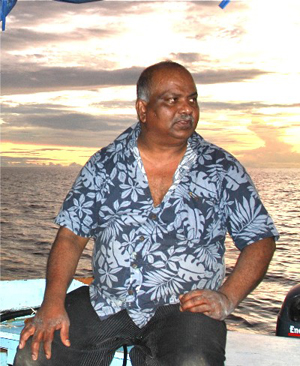
Later this month we’ll be examining some of the arguments pro and con the 100-mile diet, but for now the story I want to tell you is about a fisherman/chef who operates Surf’n Turf, a restaurant in Savusavu, Fiji.
Vijan Kumar grew up on a small Fijian island where he found work as a gardener at Musket Cove, a local resort. He moved from the garden into the kitchen, and later moved to Vanua Levu to work at Koro Sun, then at Namale, a 5-star very upmarket resort that hosts the likes of Oprah.
Vijun then moved up as executive chef at Nakoro, recently reinvented as the Jean-Michel Cousteau Diving Resort near Savusavu. The resort’s owner was Mike Freed, who runs the Post Ranch Inn in Big Sur—the sine qua non of California restaurant experiences. Freed sent Vijun to California and Europe for inspiration and experience. By the time he left the resort, Vijun had trained many of the chefs now working in resort kitchens throughout Fiji.
Ten years ago, Vijun opened his own restaurant in Savusavu. He oversees the small kitchen with two or three young Fijians as help. His wife and sometimes his daughters front the house—a restaurant with ten tables and a patio sitting ten meters from the seashore.
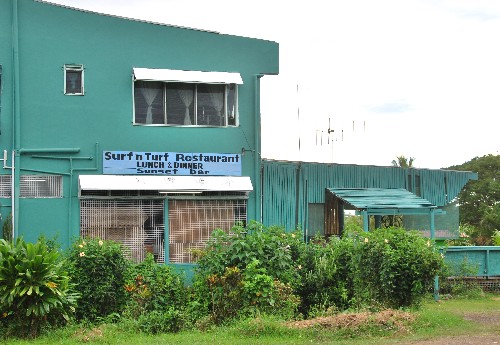
It’s far from a fancy place, but pleasant and open with a view of the bay and the boats.
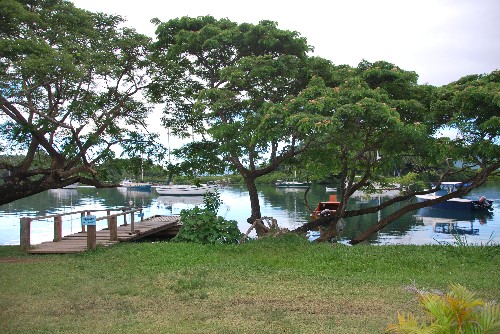
Vijun’s fishboat is tethered to a mooring buoy in Savusavu Bay, the long painter hooked around a branch of the plane tree overhanging the dock and the water. It’s a wood boat painted blue and white powered with a 45 HP “older” engine. Ground tackle (the anchor) is a steel pipe skewered by five bent rebar welded on pieces—and deployed when we get out into the bay past the oyster farm on the edge of the Koro Sea.
Vijun has been fishing all his life, and fishing is pastime, hobby and security. Most Fijians know how to net fish by just walking out into the reef, but a boat allows bigger fish, larger catches. We were out from 5 pm to almost midnight with Vijun and his assistant Lino Liesa, catching mainly snapper, using hand lines on large reels and live tiny bait. One of my catches came up securely snared in the hook but with only the head still there—a bigger fish had snapped off the tail and belly as I reeled him in. All told we must have taken about 20 snapper between 2 and 3 lbs each—most of which were destined to feed Lino’s five children.
Fresh bait was the trick here—we were fishing for bait mackerel with hand-held nets for several hours before Vijun caught his goal: a metre-long walu, or Spanish mackerel, one of the prized food fishes of Fiji and one we had eaten often in his restaurant.
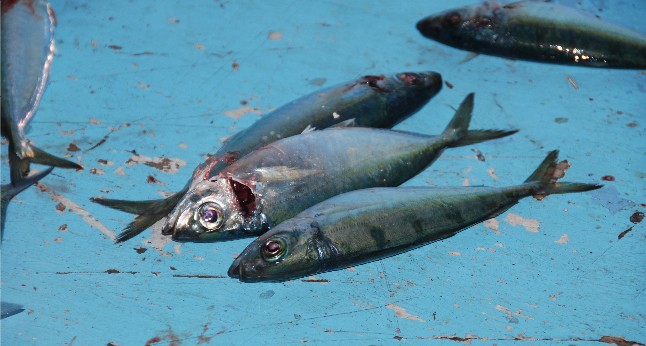
An aggressive firm-fleshed fish with alarming teeth, this one leaped around terrifyingly on the floor of the boat until Lino thumped him on the head with a mallet. We also caught and threw back in alive a number of pilot fish, small sharks with unpleasant faces and lively action—one of whom had probably eaten my half-gone snapper.
Vijun’s kitchen offers Indian influenced fish curries, fried fish, and kokoda, pronounced kokunda, in the Fijian way of adding an N between the vowel and the last consonant (all Fijian words end with a vowel) as well as chicken and some lamb, and of course burgers.
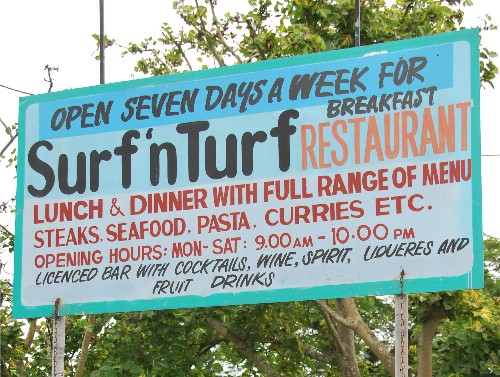
My favorite was the Red Curry Lobster Soup, with huge chunks of lobster, green beans, carrot and lemon grass—spicy but with big flavour—the lobster is local and small, so it’s mainly the tail that goes into the soup. We had bought some and cooked them at home earlier. The menu is on a chalkboard and changes according to the catch.

Vijun’s recipe for kokoda calls for walu, but I made it with local halibut. It’s a Fijian version of ceviche—fish cooked in lime juice and flavoured with onion and peppers. In this version, the fish cooks in vinegar—then you rinse it all off, drain it well, and add the lime juice. There’s no pickle or vinegar flavour at all—and the coconut cream adds an exotic sweetness that counteracts the lime and mellows the onion. Nothing tastes more of the sea.
I’ve made kokoda with fresh salmon too, and have also used frozen tilapia. If you use frozen fish, thaw it slowly, rinse it well and use it immediately. The flesh won’t have quite the same firmness as fresh, but it’s somewhat acceptable. If you omit the coconut milk as for ceviche, the dish goes very low-cal.
You can make your own coconut milk by soaking dried coconut in water then wringing out the mush in a towel and collecting the milk in a bowl.
Kokoda Ingredients
Vary the appearance of the kokoda by using yellow peppers and tomatoes or red ones, or mix them up.
1.5 lbs fresh white firm-fleshed fish such as halibut, walu, cod, or tilapia
1 cup white vinegar
2-3 limes
1 can coconut milk or freshly squeezed coconut cream
1 onion, finely diced
2 tomatoes, diced
1 red or yellow pepper, finely diced
3 cloves garlic, minced
1 avocado (optional), diced
2-3 small red hot chilis, or chili flakes. See end note.
1 tsp sugar
1 tsp balsamic vinegar
1 cup fresh fresh basil leaves
sea salt and pepper to taste
1 coconut shell if available
2 banana leaves to place under the coconut shell
(Good luck with this in Revy!)
Steps
1. Carefully cut the raw fresh fish into dice about ½ to ¾ inch, eliminating any bones and skin.
2. Soak the fish in the cup of white vinegar for 1 hour.
3. Drain well and rinse thoroughly using as sieve or colander with cold water
4. Refrigerate while you cut up the veggies for the salsa.
5. When salsa is done, put the kokoda into a coconut shell and place this on a banana leaf. In the absence of these, I used a cabbage leaf as a bowl, but lining a bowl with any greens would do.
Salsa for kokoda
1. Make small dice of the onion, peppers and if you use avocado this too..
2. Mix with 1.5 cups coconut milk or cream and the sugar.
3. Squeeze two or three limes and add the juice.
5. Mix in the fish. Taste. If you want more citrus, add more lemon or lime juice. For best results, use fresh, not frozen or bottled. The flavour is different. If the mixture is TOO spicy for you, remove some or all of the chilis.
6. Chop roughly the basil leaves and add to the kokoda
7. Taste for salt and add sea salt accordingly, and pepper to taste.
NOTE: Chilis differ in flavour and heat. I bought a handful of small red ones, and used three here—one chopped finely. In the end I took out the whole ones and a few of the larger bits of the other. Try half of one, or use ¼ tsp of chili flakes at a time.



